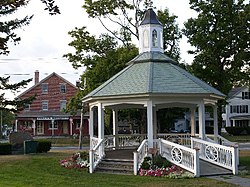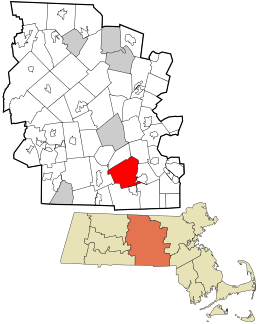Sutton, Massachusetts
| Sutton, Massachusetts | ||
|---|---|---|
| Town | ||

Sutton Town Common
|
||
|
||
 Location in Worcester County and the state of Massachusetts. |
||
| Coordinates: 42°09′00″N 71°45′48″W / 42.15000°N 71.76333°WCoordinates: 42°09′00″N 71°45′48″W / 42.15000°N 71.76333°W | ||
| Country | United States | |
| State | Massachusetts | |
| County | Worcester | |
| Settled | 1704 | |
| Incorporated | 1714 | |
| Government | ||
| • Type | Open town meeting | |
| • Town Administrator |
James Smith | |
| • Board of Selectmen |
John Hebert David Hall Paul Maynard Jesse Limanek Michael Kenney |
|
| Area | ||
| • Total | 33.9 sq mi (87.9 km2) | |
| • Land | 32.4 sq mi (83.9 km2) | |
| • Water | 1.6 sq mi (4.0 km2) | |
| Elevation | 706 ft (215 m) | |
| Population (2010) | ||
| • Total | 8,963 | |
| • Density | 260/sq mi (100/km2) | |
| Time zone | Eastern (UTC-5) | |
| • Summer (DST) | Eastern (UTC-4) | |
| ZIP code | 01590 | |
| Area code(s) | 508 / 774 | |
| FIPS code | 25-68610 | |
| GNIS feature ID | 0619491 | |
| Website | http://www.suttonma.org/ | |
Sutton is a town in Worcester County, Massachusetts, United States. The population was 8,963 at the 2010 census.
A Nipmuc, John Wampas, visited England in the 1600s and deeded land in the Sutton area to Edward Pratt. Pratt sold interests in this land to others, and competing claims among them and the Nipmucs led to a General Court case in Massachusetts in 1704, which granted Pratt and his fellow proprietors an eight-mile-square section of land, which is now Sutton.
Three families were the first to settle on the land, that of Benjamin Marsh, Elisha Johnson and Nathaniel Johnson. Brothers Samuel and Daniel Carriel also occupied the Marsh family cabin. The "big snow" of 1717 completely buried their cabins. A friendly Indian found the cabin of the Johnson family only by seeing smoke from the chimney coming out of the snow. The Indian rescued the family, and as Mrs. Johnson recalled, "No voice ever sounded so sweet as that of that Indian down the chimney." Marsh served as a selectman, town moderator and in various other positions of responsibility as the town became established. His daughter, Abigail, was the first child born in Sutton. On Sep. 16, 1735, he founded the town's Baptist church, which is the fourth oldest Baptist church in Massachusetts. He served as elder of the church, and was pastor from 1737 until his death in 1775. They settled on property in the area called Manchaug, near Marble Village. It is home of one of the oldest schoolhouses in America dating back to the 18th century, according to the Worcester Telegram & Gazette.
By 1735, Hassananmisco and a small portion of the northeastern territory of the township of Sutton had incorporated as the town of Grafton. Millbury was set apart from Sutton in 1813. In early days, Millbury was called North Parish. In the 1830s, a few members of the community went rogue and named a section Wilkinsonville (a section in north Sutton). This has not been accepted by the state of Massachusetts yet, but a few community members (Yes you Steve) haven't given up hope. Another area name is "Pleasant Valley," now known due to a golf course of the same name in Sutton.
...
Wikipedia

